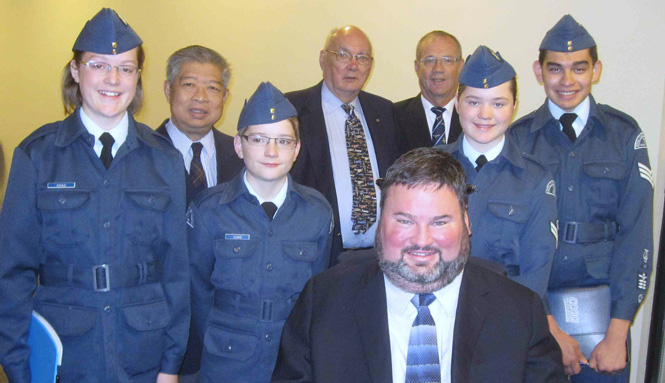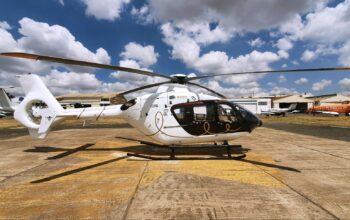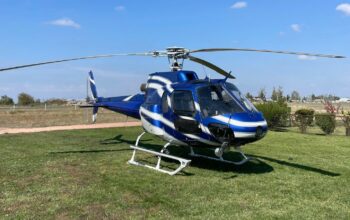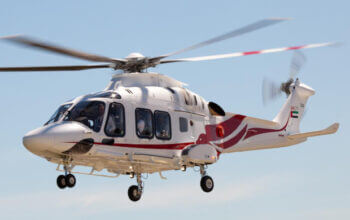Estimated reading time 21 minutes, 23 seconds.
The Hon. Steven Fletcher (front centre), Minister of State (Transport), brought greetings from the federal government. He met with members of the Air Cadet League before addressing the Forum. Bill Zuk Photo
Canadian Skies sent correspondent Fred Petrie to the 20th annual Canadian Council for Aviation & Aerospace (CCAA) AGM and Forum, October 20-21 in Winnipeg. He discovered that despite its 20-year history it a group that has a relatively low profile in the aviation industry. So how is this organization focusing on the future? Read on to find out¦
The Canadian Council for Aviation and Aerospace has evolved from the Canadian Aviation Maintenance Council (CAMC) to address current and future labour and skills shortages throughout aviation and aerospace. It is currently funded within the Sector Councils program administered by Human Resources and Skills Development Canada (HRSDC). The HRSDC website explains that: Sector councils are national partnership organizations that bring together business, labour and educational stakeholders to share ideas, concerns and perspectives about human resources and skills issues, and find solutions to enhance adult workers’ skills through activities such as increasing employer investments in skills development and promoting workplace learning and training.
Three sector councils were formed through independent initiatives during the 1980s. In 1989, formal human resource planning began with the Labour Force Development Strategy (LFDS) that led to the development of sector councils as a means to address the human resource needs that were identified through sector studies forward-looking industry analyses that examine how changes in business and technology relate to human resource issues in specific sectors of the Canadian economy. The 1992 Sector Partnerships Initiative (SPI) expanded the LFDS to include national occupational standards and skills upgrading.
Within this context, CAMC was formed to address skills development in aircraft maintenance. The only standards to that point were the AME licensing programs, but those did not consider HR issues like attracting people to the field. As well, there were no national standards for the many other related trades, from welders to painters. Over the last decade, CAMC got involved with the study of commercial pilots and with manufacturers who needed national standards for trades, from gas turbine engines to composites to non-destructive-testing. Rather than establish more councils for operators and manufacturers, with obvious overlaps, industry cooperated in morphing CAMC into CCAA to address all HR challenges in aviation and aerospace. This past year, as CCAA reviewed its strategies within this broader mandate, a new name was adopted to reflect its expanded scope. Through CCAA work to ensure that the industry future HR needs are known, then facilitating HR skills development within nationally-accepted standards, CCAA will be contributing to your future whether you are an employer or trades professional.
The 20th annual forum addressed many issues and initiatives. First, aviation and aerospace will be competing with many other industries for the diminishing supply of human resources. To sell the opportunities in our industry, CCAA has youth outreach programs, such as the Air Cadets and growing secondary school programs already in some 27 schools across Canada. Two historically under-represented demographics have been women and aboriginal populations; the 2011 CCAA Forum had very interesting panels on initiatives in both areas. These initiatives will help ensure we have enough people coming in to aviation and aerospace.
The Council develops and coordinates curricula for training organizations that address the competencies identified in the NOS; it is currently working with flight schools across the country towards a national curriculum for pilots, beyond the minimum standards covered in licensing. CCAA accredits training organization programs, such as it was doing in Winnipeg for the Aboriginal Aerospace Initiative developed by the Neeginan Institute of Technology with the Manitoba Aerospace Human Resources Council (a provincial counterpart to CCAA). In some cases, CCAA even delivers training. A major initiative of the last few years has been in quality audits and assurance associated with the new regulatory direction in Safety Management Systems (see my column in the upcoming Jan/Feb issue of Canadian Skies). Training provided by CCAA has focussed in priority areas, where CCAA training can be proven and then incorporated into others’ training curricula, such as in human factors, fatigue management, surface contamination (i.e. icing) and quality assurance/safety management.
All CCAA programs are driven by industry which first identifies the occupations that would benefit from having national standards. It is industry experts who identify the experience and knowledge required to perform the occupation and defines the skills needed to perform professionally. When an employer hires someone with CCAA certification and record of experience in their logbook, he knows what he is getting and will save on training costs.
Another sector increasingly demanding CCAA attention is the definition of NOSs for airport workers. Where Transport Canada had been the primary source of airport trades training when it ran most airports, devolution has left the individual airport authorities or even the public works departments of municipalities scrambling for proper training. Through CCAA coordination, the Harvard Manage Mentor program, in 42 courses online, has been made available to member companies seeking to improve management skills.
CCAA is looking to the industry future needs, where 40% of the work force will be over 50 in only five more years. The future labour force shortages will be further exacerbated by skills shortages where even when workers are available they will not necessarily have the skills needed. Robert Donald, Executive Director of CCAA, included some aviation requirements in his AGM report. Internationally, the demand for new pilots, for aircraft already on order and retirements, will be 207,600 by 2018 and will grow to 352,900 by 2026. On the maintenance side we will need 405,500 more by 2018 and 739,000 by 2026. Donald also highlighted the current Canadian labour force in aviation and aerospace. We have some 80,000 workers in aviation maintenance, another 80,000 in aerospace manufacturing (over 80% of its $22.2 billion in revenues is exports), 25,000 commercial pilots and almost 4,000 airport workers, plus tens of thousands more not categorized in that breakdown (some 23,000 at Air Canada alone).
Donald report card highlighted what have we done for you lately with projects completed in 2010. The development of its Labour Market Information Management System tracks demand while its aviation and aerospace courses/programs survey has looked into the supply side. CCAA completed its HR study of commercial pilots with ATAC while looking at airports occupation rationalization with the CAC. Work was undertaken in prior learning assessment so skilled immigrants as well as retiring military specialists can have their skills recognized. Donald concluded by reviewing CCAA active projects for the current year, from an Occupational Standard for commercial pilots (that goes far beyond TC minimum licensing standards), further AMT curriculum development, attracting youth to the industry, facilitation initiatives such as expanding apprenticeship where youth can earn while they learn, and marrying the supply and demand sides through human resource action plans for employers and training organizations. That is just a sampling of how CCAA will help to look after your future in aviation.









